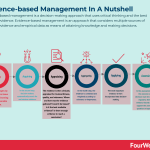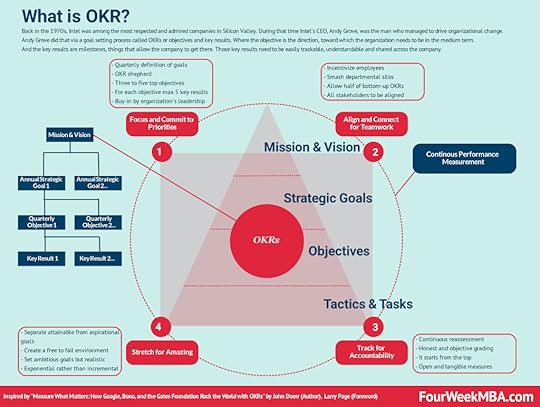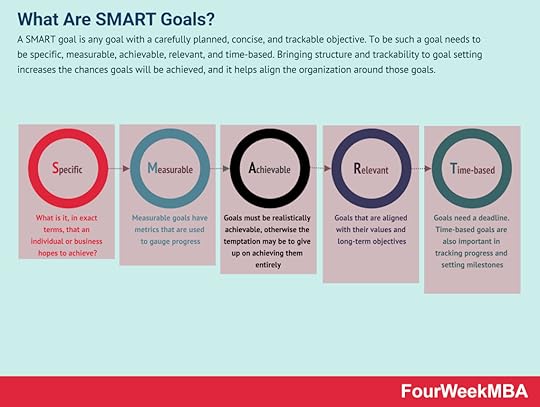What Is Evidence-based Management? Evidence-based Management In A Nutshell


Evidence-based management is a decision-making approach that uses critical thinking and the best available evidence. Evidence-based management is an approach that considers multiple sources of scientific evidence and empirical data as means of attaining knowledge and making decisions.
Understanding evidence-based managementThis means scientific literature is used to answer questions, guide strategy decisions, and formulate long-term plans. Evidence-based management is an emerging movement that forms part of the larger transition to evidence-based practices.
The transition began to gather momentum after the introduction of evidence-based medicine in 1992, with the approach quickly spreading to education, law, public policy, architecture, and many other fields.
Ultimately, the goal of an evidence-based approach is to encourage professionals to give more credence to evidence while making decisions. The approach seeks to replace the ineffective practices that base decision-making on tradition, intuition, and personal experience.
The key components of evidence-based managementIn a nutshell, evidence-based management is based on three key components:
The best available evidence – this means evaluating multiple sources of scientific evidence and empirical results to discover new interventions and strategies. In addition to scientific research, evidence may take the form of organizational data, professional expertise, or stakeholder values and concerns.Systematic decision-making – decisions are made by considering the published literature, critically appraising evidence, and crafting a strategy underpinned by science. Mental biases, prejudices, or lazy thinking must be reduced or eliminated.Re-evaluating and adapting – all decisions must be critically examined and evaluated using the scientific method. Consistently evaluating the original hypothesis is the only way to determine whether the strategy or decision had its intended effect.Incorporating evidence-based managementTo deliver better outcomes in an organizational context, the Chartered Institute of Personnel and Development and the Center for Evidence-Based Management developed six steps:
Asking – the process begins by taking a practical issue or problem and turning it into an answerable question.Acquiring – in the second step, decision-makers systematically search for and retrieve evidence.Appraising – the evidence is then critically appraised for trustworthiness, quality, and relevance. Where and how was the evidence gathered? Could it be biased? Is it the best available evidence? Is there enough evidence to reach a conclusion?Aggregating – in the fourth step, the evidence is combined and weighted according to relevance or importance.Applying – the most important evidence is then incorporated into decision-making.Assessing – in the assessment stage, the outcome of the decision must be evaluated regularly. Does the evidence-based decision support the answerable question or hypothesis? Key takeaways:Evidence-based management is a decision-making approach that uses critical thinking and the best available evidence. The approach seeks to replace decision-making based on personal experience, intuition, or tradition.Evidence-based management is based on three key components: the best available evidence, systematic decision-making, and re-evaluating and adapting. In addition to scientific research, the best available evidence may also be related to stakeholder values and concerns, internal data, and professional expertise.Evidence-based management delivers better organizational outcomes in six steps: asking, acquiring, appraising, aggregating, applying, and assessing. Collectively, the steps help decision-makers answer questions and test hypotheses. Related Goal-Setting & Growth Frameworks Andy Grove, helped Intel become among the most valuable companies by 1997. In his years at Intel, he conceived a management and goal-setting system, called OKR, standing for “objectives and key results.” Venture capitalist and early investor in Google, John Doerr, systematized in the book “Measure What Matters.”
Andy Grove, helped Intel become among the most valuable companies by 1997. In his years at Intel, he conceived a management and goal-setting system, called OKR, standing for “objectives and key results.” Venture capitalist and early investor in Google, John Doerr, systematized in the book “Measure What Matters.” A SMART goal is any goal with a carefully planned, concise, and trackable objective. To be such a goal needs to be specific, measurable, achievable, relevant, and time-based. Bringing structure and trackability to goal setting increases the chances goals will be achieved, and it helps align the organization around those goals.
A SMART goal is any goal with a carefully planned, concise, and trackable objective. To be such a goal needs to be specific, measurable, achievable, relevant, and time-based. Bringing structure and trackability to goal setting increases the chances goals will be achieved, and it helps align the organization around those goals. First proposed by accounting academic Robert Kaplan, the balanced scorecard is a management system that allows an organization to focus on big-picture strategic goals. The four perspectives of the balanced scorecard include financial, customer, business process, and organizational capacity. From there, according to the balanced scorecard, it’s possible to have a holistic view of the business.
First proposed by accounting academic Robert Kaplan, the balanced scorecard is a management system that allows an organization to focus on big-picture strategic goals. The four perspectives of the balanced scorecard include financial, customer, business process, and organizational capacity. From there, according to the balanced scorecard, it’s possible to have a holistic view of the business. The theory was developed by psychologist Edwin Locke who also has a background in motivation and leadership research. Locke’s goal-setting theory of motivation provides a framework for setting effective and motivating goals. Locke was able to demonstrate that goal setting was linked to performance.
The theory was developed by psychologist Edwin Locke who also has a background in motivation and leadership research. Locke’s goal-setting theory of motivation provides a framework for setting effective and motivating goals. Locke was able to demonstrate that goal setting was linked to performance. Businesses use backcasting to plan for a desired future by determining the steps required to achieve that future. Backcasting is the opposite of forecasting, where a business sets future goals and works toward them by maintaining the status quo.
Businesses use backcasting to plan for a desired future by determining the steps required to achieve that future. Backcasting is the opposite of forecasting, where a business sets future goals and works toward them by maintaining the status quo. Moonshot thinking is an approach to innovation, and it can be applied to business or any other discipline where you target at least 10X goals. That shifts the mindset, and it empowers a team of people to look for unconventional solutions, thus starting from first principles, by leveraging on fast-paced experimentation.
Moonshot thinking is an approach to innovation, and it can be applied to business or any other discipline where you target at least 10X goals. That shifts the mindset, and it empowers a team of people to look for unconventional solutions, thus starting from first principles, by leveraging on fast-paced experimentation. fixed mindset believes their intelligence and talents are fixed traits that cannot be developed. The two mindsets were developed by American psychologist Carol Dweck while studying human motivation.Both mindsets are comprised of conscious and subconscious thought patterns established at a very young age. In adult life, they have profound implications for personal and professional success.Individuals with a growth mindset devote more time and effort to achieving difficult goals and by extension, are less concerned with the opinions or abilities of others. Individuals with a fixed mindset are sensitive to criticism and may be preoccupied with proving their talents to others.
fixed mindset believes their intelligence and talents are fixed traits that cannot be developed. The two mindsets were developed by American psychologist Carol Dweck while studying human motivation.Both mindsets are comprised of conscious and subconscious thought patterns established at a very young age. In adult life, they have profound implications for personal and professional success.Individuals with a growth mindset devote more time and effort to achieving difficult goals and by extension, are less concerned with the opinions or abilities of others. Individuals with a fixed mindset are sensitive to criticism and may be preoccupied with proving their talents to others. At its core, a growth mindset sees opportunities instead of obstacles. Despite scientific evidence to the contrary, many individuals believe their intelligence, talents, and skills do not advance once they reach adulthood. An eagerness to learn is something every person with a growth mindset possesses.
At its core, a growth mindset sees opportunities instead of obstacles. Despite scientific evidence to the contrary, many individuals believe their intelligence, talents, and skills do not advance once they reach adulthood. An eagerness to learn is something every person with a growth mindset possesses. Hockey stick growth is a pattern where company growth is slow until an inflection point is reached and the growth becomes exponential. The line connecting the numerous data points resembles the shape of a hockey stick, which gives the concept its name. Hockey stick growth is, therefore, a term used to describe a line chart in which there is a sudden sharp increase after a period of relative dormancy. Related Case Studies
Hockey stick growth is a pattern where company growth is slow until an inflection point is reached and the growth becomes exponential. The line connecting the numerous data points resembles the shape of a hockey stick, which gives the concept its name. Hockey stick growth is, therefore, a term used to describe a line chart in which there is a sudden sharp increase after a period of relative dormancy. Related Case Studies The innovation loop is a methodology/framework derived from the Bell Labs, which produced innovation at scale throughout the 20th century. They learned how to leverage a hybrid innovation management model based on science, invention, engineering, and manufacturing at scale. By leveraging individual genius, creativity, and small/large groups.
The innovation loop is a methodology/framework derived from the Bell Labs, which produced innovation at scale throughout the 20th century. They learned how to leverage a hybrid innovation management model based on science, invention, engineering, and manufacturing at scale. By leveraging individual genius, creativity, and small/large groups. In a business world driven by technology and digitalization, competition is much more fluid, as innovation becomes a bottom-up approach that can come from anywhere. Thus, making it much harder to define the boundaries of existing markets. Therefore, a proper business competition analysis looks at customer, technology, distribution, and financial model overlaps. While at the same time looking at future potential intersections among industries that in the short-term seem unrelated.
In a business world driven by technology and digitalization, competition is much more fluid, as innovation becomes a bottom-up approach that can come from anywhere. Thus, making it much harder to define the boundaries of existing markets. Therefore, a proper business competition analysis looks at customer, technology, distribution, and financial model overlaps. While at the same time looking at future potential intersections among industries that in the short-term seem unrelated. Business scaling is the process of transformation of a business as the product is validated by wider and wider market segments. Business scaling is about creating traction for a product that fits a small market segment. As the product is validated it becomes critical to build a viable business model. And as the product is offered at wider and wider market segments, it’s important to align product, business model, and organizational design, to enable wider and wider scale.
Business scaling is the process of transformation of a business as the product is validated by wider and wider market segments. Business scaling is about creating traction for a product that fits a small market segment. As the product is validated it becomes critical to build a viable business model. And as the product is offered at wider and wider market segments, it’s important to align product, business model, and organizational design, to enable wider and wider scale.  Disruptive innovation as a term was first described by Clayton M. Christensen, an American academic and business consultant whom The Economist called “the most influential management thinker of his time.” Disruptive innovation describes the process by which a product or service takes hold at the bottom of a market and eventually displaces established competitors, products, firms, or alliances.
Disruptive innovation as a term was first described by Clayton M. Christensen, an American academic and business consultant whom The Economist called “the most influential management thinker of his time.” Disruptive innovation describes the process by which a product or service takes hold at the bottom of a market and eventually displaces established competitors, products, firms, or alliances.  An innovation funnel is a tool or process ensuring only the best ideas are executed. In a metaphorical sense, the funnel screens innovative ideas for viability so that only the best products, processes, or business models are launched to the market. An innovation funnel provides a framework for the screening and testing of innovative ideas for viability.
An innovation funnel is a tool or process ensuring only the best ideas are executed. In a metaphorical sense, the funnel screens innovative ideas for viability so that only the best products, processes, or business models are launched to the market. An innovation funnel provides a framework for the screening and testing of innovative ideas for viability. A four-step innovation process is a simple tool that businesses can use to drive consistent innovation. The four-step innovation process was created by David Weiss and Claude Legrand as a means of encouraging sustainable innovation within an organization. The process helps businesses solve complex problems with creative ideas instead of relying on low-impact, quick-fix solutions.
A four-step innovation process is a simple tool that businesses can use to drive consistent innovation. The four-step innovation process was created by David Weiss and Claude Legrand as a means of encouraging sustainable innovation within an organization. The process helps businesses solve complex problems with creative ideas instead of relying on low-impact, quick-fix solutions. Innovation in the modern sense is about coming up with solutions to defined or not defined problems that can create a new world. Breakthrough innovations might try to solve in whole new way, well-defined problems. Business innovation might start by finding solutions to well-defined problems by continuously improving on them.
Innovation in the modern sense is about coming up with solutions to defined or not defined problems that can create a new world. Breakthrough innovations might try to solve in whole new way, well-defined problems. Business innovation might start by finding solutions to well-defined problems by continuously improving on them.Read Next: High-Performance Management.
Read Also: Eisenhower Matrix, BCG Matrix, Kepner-Tregoe Matrix, Decision Matrix,RACI Matrix, SWOT Analysis, Personal SWOT Analysis, TOWS Matrix, PESTEL Analysis, Porter’s Five Forces.
Main Free Guides:
Business ModelsBusiness StrategyBusiness DevelopmentDigital Business ModelsDistribution ChannelsMarketing StrategyPlatform Business ModelsRevenue ModelsTech Business ModelsBlockchain Business Models FrameworkThe post What Is Evidence-based Management? Evidence-based Management In A Nutshell appeared first on FourWeekMBA.



